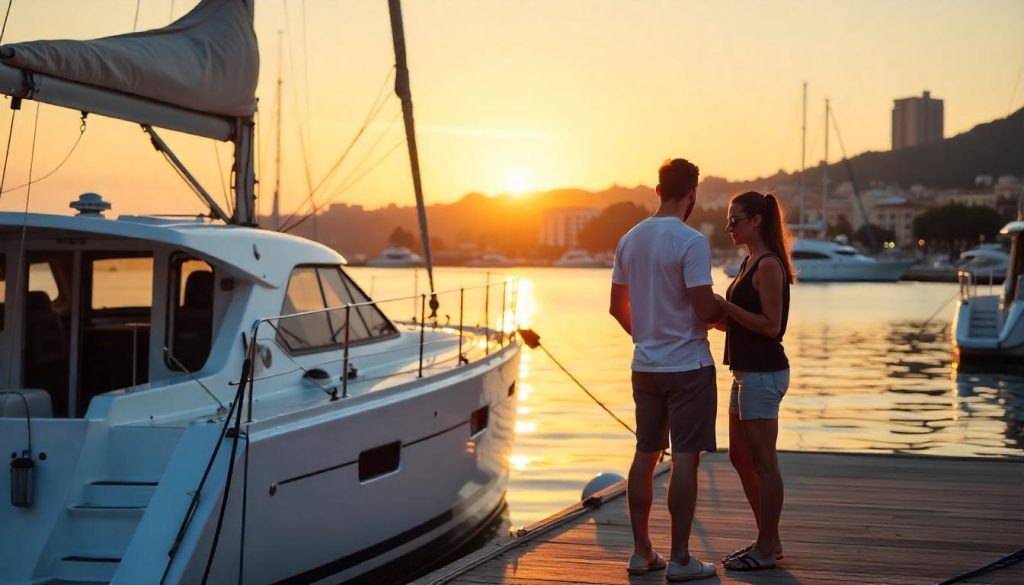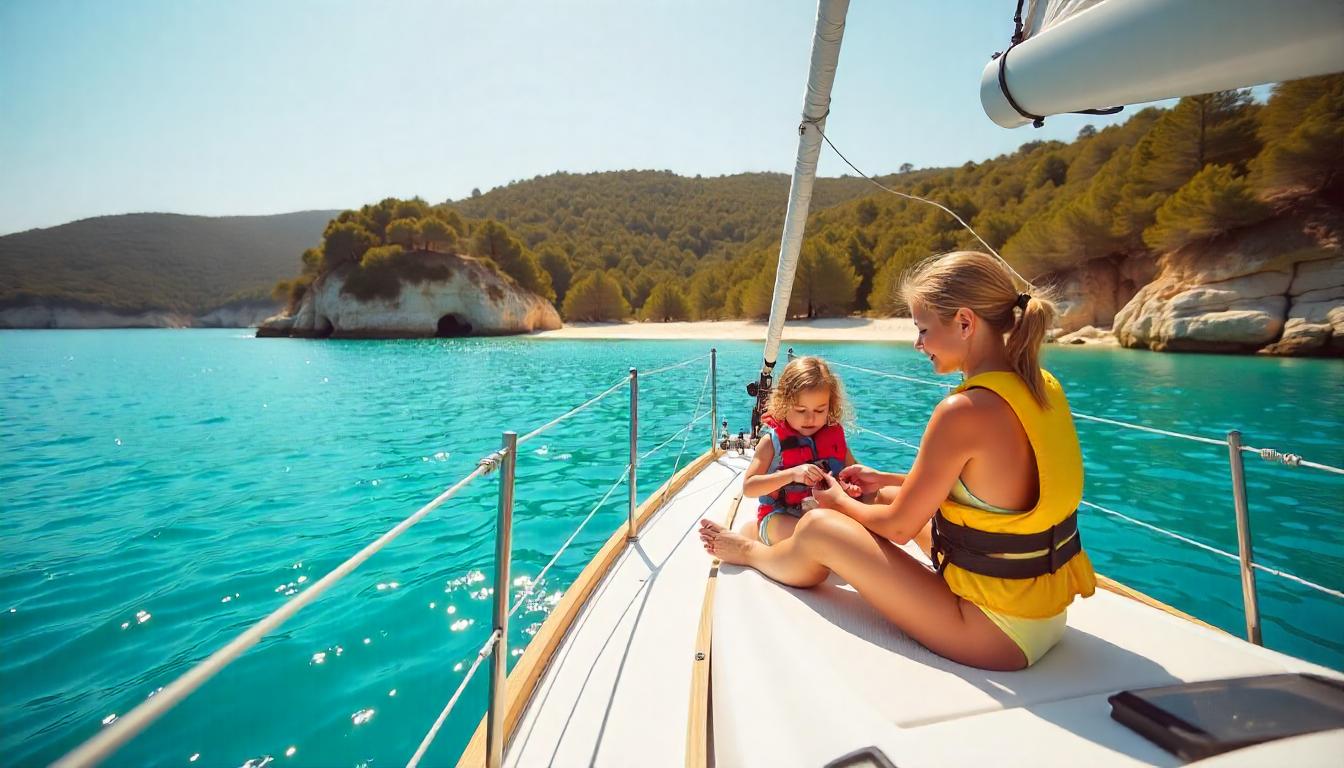Spain, with its 8,000 km of coastline and sun-drenched Mediterranean waters, is a dream destination for novice sailors, and yachting in Spain tips for first-time sailors can help ensure a smooth and enjoyable maiden voyage. From the Balearic Islands to the Costa del Sol, Spain offers calm waters, vibrant marinas, and stunning scenery, making it an ideal place to start your sailing journey. In this guide, we’ll provide essential yachting in Spain tips, covering planning, safety, navigation, and more, to help beginners navigate Spain’s shores with confidence.
Why Choose Yachting in Spain for Beginners?
Yachting in Spain is perfect for first-time sailors due to its favorable conditions and infrastructure. For starters, the Mediterranean’s calm waters, with summer winds averaging 5-15 knots, are ideal for beginners learning to sail. Moreover, Spain has over 300 marinas, like Marina Port Vell in Barcelona, offering modern facilities and support for new sailors. Consequently, yachting in Spain tips can help you make the most of these conditions while ensuring a safe and fun experience.
The Appeal of Sailing in Spain
Spain’s appeal lies in its diversity and accessibility. For instance, you can sail to secluded coves in Mallorca one day and explore vibrant cities like Málaga the next. Additionally, the warm climate—summer temperatures average 28°C—makes sailing comfortable, even for beginners. This combination of natural beauty and beginner-friendly conditions makes yachting in Spain tips essential for a successful first trip.
Planning Your Trip: Yachting in Spain Tips for Beginners
Proper planning is key for first-time sailors. First, choose the right time to sail—May and September are ideal, with temperatures around 24°C and fewer crowds than peak season (July-August). Next, select a beginner-friendly destination like Mallorca, where the waters are calm, and marinas like Puerto Portals charge $80 per night for a 40-foot yacht. Also, book your yacht early—charter companies like Sunsail offer 40-foot yachts for $3,000 per week, or $750 per person for four people.
Choosing the Right Yacht and Crew
Selecting the right yacht is crucial. For example, a 40-foot monohull is manageable for beginners, offering stability and ease of handling. If you’re unsure about sailing solo, hire a skipper for $200 per day—they’ll handle navigation and teach you the basics. Transitioning to crew, ensure everyone knows their roles—assign simple tasks like coiling ropes to build confidence. Thus, proper planning sets the foundation for a successful yachting trip in Spain.
Safety First: Yachting in Spain Tips for a Secure Voyage
Safety is a top priority for first-time sailors. First, ensure everyone wears a life jacket—children’s sizes cost $30 at most marinas, and adults’ are $50. Next, check the yacht’s safety equipment—life rafts, flares, and a VHF radio should be onboard, as required by Spanish maritime law. Also, familiarize yourself with the weather—apps like Windy can predict winds like the Levante, which can reach 20 knots on the Costa del Sol.
الاستعداد لحالات الطوارئ
Preparation can prevent emergencies. For instance, take a basic first-aid course before your trip—online courses cost $20 and cover essentials like treating sunburns, common on the Mediterranean with a UV index of 8. Additionally, know how to use the VHF radio—channel 16 is for emergencies in Spain. Transitioning to navigation, always have a backup plan—if winds pick up, head to a sheltered cove like Cala Turqueta in Menorca. Therefore, safety-focused yachting in Spain tips ensure a secure journey.
Navigation Basics: Yachting in Spain Tips for First-Timers
Navigation can seem daunting, but these yachting in Spain tips make it manageable for beginners. First, start with short sails—Mallorca to Menorca is 40 nautical miles, but a 5-nautical-mile trip from Palma to Cala Pi is more beginner-friendly. Next, use a GPS chartplotter, standard on most charter yachts, to track your position—familiarize yourself with it before setting sail. Also, carry paper charts as a backup, available for $20 at marinas like Puerto Banús in Marbella.
Understanding Local Conditions
Local conditions affect navigation. For example, the Garbí wind in Barcelona, a sea breeze, can reach 15 knots in the afternoon, so plan to sail in the morning when winds are lighter, around 5 knots. Additionally, be aware of busy ports—Barcelona’s port has heavy ferry traffic, so keep a safe distance and follow buoy markers. Transitioning to practice, do a test sail in a marina’s calm waters to build confidence before heading out. Thus, these navigation tips help beginners sail Spain’s waters safely.

Anchoring and Mooring: Yachting in Spain Tips for Success
Anchoring and mooring are key skills for first-time sailors. First, practice anchoring in a sandy seabed—coves like Cala Jondal in Ibiza have ideal conditions, and anchoring is free. Drop the anchor slowly, ensuring it sets by reversing the yacht gently. Next, when mooring in a marina, like Marina de Denia on the Costa Blanca ($70 per night for a 40-foot yacht), call ahead on VHF channel 9 to reserve a spot and get docking assistance.
Tips for Stress-Free Mooring
Mooring can be tricky, but preparation helps. For instance, assign a crew member to handle fenders—rubber bumpers that protect the yacht, costing $10 each to rent. Also, approach the dock slowly, at 1-2 knots, to avoid collisions—marinas often have staff to catch your lines, making the process easier. Transitioning to anchoring, always check the depth—use a depth sounder to ensure at least 3 meters under the keel in shallow coves. Therefore, these yachting in Spain tips make anchoring and mooring manageable for beginners.
Exploring Destinations: Yachting in Spain Tips for First-Time Adventures
Spain offers diverse destinations for first-time sailors. Start in Mallorca, where Cala Mondragó’s shallow waters (1-2 meters deep) are perfect for swimming—anchor for free and enjoy the white-sand beach. Next, sail to Formentera’s Playa de Ses Illetes, 11 nautical miles from Ibiza, where the turquoise waters are ideal for paddleboarding—rentals cost $20 per hour. Also, explore the Costa del Sol—Fuengirola’s marina charges $65 per night and is near family-friendly beaches like Playa de Los Boliches.
Cultural Stops Along the Way
Yachting in Spain isn’t just about sailing—it’s also about culture. For example, in Málaga, moor at Muelle Uno ($70 per night) and visit the Picasso Museum, a 10-minute walk away, for $12 per person. Additionally, in Barcelona, dock at Marina Port Vell ($110 per night) and explore the Gothic Quarter—entry to the Barcelona Cathedral costs $9. Transitioning to relaxation, enjoy a tapas dinner at a marina restaurant—expect to spend $15 per person. Thus, these yachting in Spain tips help beginners balance sailing with cultural exploration.
Budgeting for Your Trip: Yachting in Spain Tips for Cost Management
Budgeting is essential for first-time sailors. A 7-day trip for four people might include a yacht charter at $3,000, or $750 per person. Mooring fees average $80 per night, totaling $560, though anchoring in free spots like Cala Turqueta saves costs. Fuel for 100 nautical miles costs $200, and meals at coastal restaurants average $15 per person daily, or $420 for four. Activities like paddleboarding ($20) and museum visits ($12) total $128 per person. Total: about $4,858 for four, or $1,214 per person.
Saving Money on Your First Yachting Trip
You can save with smart choices. For instance, anchor in free spots instead of marinas—anchoring off Playa de Ses Illetes saves $65 per night compared to Fuengirola. Also, cook onboard using local markets—ingredients for a seafood paella in Mallorca cost $15 for four, versus $60 at a restaurant. Transitioning to charters, book early to secure discounts, often 10% off, and avoid peak season for lower rates. Therefore, these yachting in Spain tips help keep your trip affordable.
Challenges of Yachting in Spain: Tips for First-Timers
First-time sailors may face challenges. First, peak season (July-August) means crowded marinas and beaches, especially in Ibiza. Additionally, unexpected weather, like the Tramontana wind in Mallorca, can reach 20 knots, requiring you to stay in port. Also, navigating busy ports like Barcelona, with heavy ferry traffic, can be intimidating for beginners. However, these issues can be managed with preparation.
Overcoming First-Time Sailing Challenges
Sail in May or September to avoid crowds—marinas like Puerto Portals are less busy then. For weather, monitor apps like Windy, and have a flexible itinerary—your skipper can suggest sheltered coves if winds pick up. For busy ports, hire a local skipper for $200 per day to navigate safely, or practice in quieter areas first. Transitioning to solutions, you can enjoy a smooth sailing trip. Thus, these yachting in Spain tips ensure a stress-free first voyage.
Why Follow Yachting in Spain Tips for First-Time Sailors?
Yachting in Spain tips for first-time sailors provide the guidance needed to explore Spain’s stunning coastlines with confidence, from Mallorca’s coves to Barcelona’s vibrant ports. These tips cover planning, safety, navigation, and budgeting, ensuring a safe and enjoyable experience. Whether you’re swimming in Formentera or exploring Málaga’s culture, Spain delivers. For a memorable maiden voyage, this is the place. Therefore, yachting in Spain is a perfect start for beginners.
A First-Time Sailor’s Journey in Spain
Every tip leads to lasting memories. For instance, anchoring in Cala Mondragó and swimming with your crew feels exhilarating. Or, exploring the Gothic Quarter after docking in Barcelona adds cultural depth to your trip. This variety ensures a spectacular journey. Thus, yachting in Spain tips help first-time sailors create an adventure they’ll never forget.
Final Thoughts on Yachting in Spain Tips
Yachting in Spain tips for first-time sailors offer a roadmap to explore the country’s coastlines, from planning your trip to navigating safely and managing costs. With careful preparation, a focus on safety, and a sense of adventure, you’ll create a sailing experience that’s both thrilling and rewarding. So, charter your yacht, pack your sunscreen, and let Spain’s shores welcome you—one wave at a time.

 الإبحار باليخوت في إسبانيا: نصائح للبحارة لأول مرة">
الإبحار باليخوت في إسبانيا: نصائح للبحارة لأول مرة">
